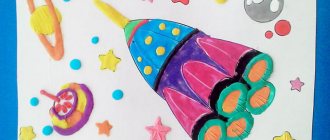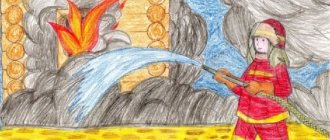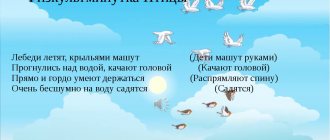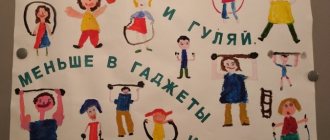The educational role of origami
Origami helps to spend leisure time and solve many educational problems .
By folding paper figures, you can develop in a child confidence in his abilities, creativity, love of art, and imagination. By improving finger movements and developing fine motor skills with the help of origami, you can influence intellectual and speech development. Exercises have a beneficial effect on memory formation. In the process, children remember the actions they perform and reproduce them in the future.
The educational role of origami is to develop independence and the formation of aesthetic taste.
The process of folding figures brings children pleasure . With the help of step-by-step actions, the child receives a car, plane, ship or frog that comes to life in his hands. Therefore, such activities are interesting to them.
Does your child do origami?
Not really
Paper is a universal constructor . It allows you to get a finished toy from an ordinary sheet. Educators use these activities in kindergartens and recommend repeating them at home.
Making crafts helps:
- develop perseverance;
- create positive feelings (after all, a toy can become a gift for loved ones);
- discipline;
- show creativity;
- favor theatrical, constructive and visual talents.
In kindergarten, origami helps prepare children for school. Classes contribute to the formation of important skills:
- the ability to listen carefully;
- take a responsible approach to the task and its implementation;
- reorient consciousness from the outcome of the task to the search for its completion;
- self-control;
- awareness of one's cognitive processes.
The main form of training is recommended to be carried out in small subgroups . Making toys requires precise finger work. The teacher needs to provide individual assistance to each child.
The main tasks of origami in the middle group:
- teach your child to design and be able to create three-dimensional crafts using this technique;
- develop finger motor skills;
- show creativity and artistic taste;
- instill patience and love of work.
When the child has formed and consolidated an idea of how to work with paper, his imagination will begin to manifest itself, and he will be able to follow the teacher’s verbal instructions. Making origami also helps with mathematical preparation. In the process of paper creativity, children study geometric shapes, including polygons, focusing on the sheet. Putting together crafts in a group helps develop communication skills and foster a desire to interact with peers and adults.
Summary of a lesson on manual labor in the senior group Topic: Frog (origami technique)
Summary of a lesson on manual labor in the senior group
Topic: Frog (origami technique)
Goals:
— formation of a holistic picture of the world;
- introduce to verbal art;
— enrichment and activation of the dictionary;
— to develop the ability to understand cause and effect relationships in the text read;
- to form a stable interest in the reading process, memorizing what has been read;
— promote the development of a caring attitude towards living nature;
- continue to teach how to perform movements in accordance with the text;
— continue to get acquainted with the origami paper folding technique;
- develop the ability to design according to plan, taking into account the characteristics of the material;
- develop fine motor skills;
- encourage and strengthen the desire to work;
— teach children to rejoice in the results obtained.
Material: text of the story “Zhaleikin and the Frog” by N. Sladkov, illustrations for the story;
handout: green origami sheet, felt-tip pens.
Preliminary work: looking at pictures of frogs; Didactic games “Who lives in the water”, “The fourth odd one”; Reading fiction: about mammals that live in water; outdoor game "Frogs".
Program content:
Educator: - Guys, listen to one very interesting story written by Nikolai Sladkov.
This story is called “Zhaleikin and the Frog.”
Under a hummock in a damp swamp, Zhaleikin noticed a small, weak frog. - Poor, unfortunate baby! – exclaimed Zhaleikin. - How bad it is for you, poor thing, in this dirty swamp! Dark, damp, cold! But don't be discouraged! I will save you, you will feel good and cozy in my home. At home, Zhaleikin put the little frog in the most beautiful painted box, laid soft dry cotton wool on the bottom, put the box in the warm sun and laughed cheerfully with joy. - Remember, little frog, my worries! You will now live in warmth, dryness and cleanliness. Not like in your dirty swamp! But the frog is not happy. But the frog is not having fun. He feels very bad, he is barely alive. It overheated in the sun, dried out and became entangled in cotton wool. When Zhaleikin saw him, he roared. He poured tears all over the little frog, and just in time: a little more and the little frog would have died. Zhaleikin rushed with the frog to the swamp. The very same place where it’s damp, dirty and cold, but where the frog feels just as good as Zhaleikin in his warm and clean room.
— Guys, what is the name of the story you just listened to? (“Zhaleikin and the Frog”)
-Who is it about?
- What did Zhaleikin do? (took the frog from the swamp to his home)
— Is the little frog happy? What happened to him? (the little frog overheated in the sun, dried out and almost died. The little frog feels bad at Zhaleikin’s house)
- What did Zhaleikin do? (carried the frog back to the swamp)
— Why can’t we take frogs from the swamp? (because the swamp is the home of frogs, they feel good and cozy there)
- Guys, let's make a frog that will be good in our home. We will make it from paper using the origami technique. But first, we will imagine ourselves as little frogs:
Physical school
Here is a frog jumping along the path with its legs stretched out. She saw a mosquito and screamed...Kwa-Kwa-Kwa!
-Now come to your tables - let's start designing.
-Now you need to draw the frog’s eyes. To do this, take felt-tip pens.
-That’s how beautiful our frogs turned out. And most importantly, such frogs will be very happy in our home. You did a very good job, Well done guys.
Methodology and options for constructing classes
Before you start making origami with your children, you need to master the basic rules of folding and working techniques, basic forms.
The implementation of the origami making technique for the senior group consists of the following points:
- carrying out system work;
- folding figures from simple to complex;
- searching for an individual approach to everyone;
- providing independent choice;
- organization of interaction;
- creation of thematic cycles.
When implementing the methodology for conducting origami classes for older preschoolers, you can use the following types of work:
- individual;
- group;
- with parents (there may be consultations, group meetings);
- creative activities together with children and their parents (for example, a circle).
Editorial Voice
Irakli
Lord of Paper Sheets
Ask a Question
Training with children, structured according to the methodology, should have three stages : initial, main, final.
Elementary
Children need to be told that the birthplace of origami is Japan . Here you can create a thematic album, watch a cartoon, play a game. The teacher can tell the children why paper is needed, what it is made from and what crafts can be made from it.
The following classes are conducted:
- The production of basic forms and simple crafts begins. It could be a book, candy or ice cream. The site for the exhibition is being prepared.
- A parent meeting is held. Parents are encouraged to collaborate with their children. A consultation is being held on the topic “Why activities with paper are so important for children”, “What can be made from paper”.
- Methodological literature is selected. A long-term plan for classes in the circle is developed, and didactic material with different levels of complexity is selected.
- A designated corner is created in the group. It will display crafts of different levels that the children were able to make. Additionally, a file cabinet with finger exercises is installed in the corner.
Basic
At this stage of training, the teacher and children face the following tasks:
- read and learn poems related to animals, flowers and insects;
- conduct experiments with paper, create a collage;
- make and present paper crafts in the shape of animals;
- organize and conduct a theatrical performance with products;
- make a panel with handicrafts made by children;
- create holiday cards;
- conduct role-playing games with products;
- organize environmental activities using origami;
- complete homework with the participation of parents;
- organize a parent seminar on the topic “Joint activities with children at home.”
If you wish, you can make a miniature museum , which will contain crafts made in the garden and at home. This is where you can display paper gifts for parents.
Final
At this stage, children can already “play out” new figures on their own. New goals are set for them:
- find a new way to fold it yourself;
- make a picture or card using only a specific piece of paper.
During this period, it is important to consolidate the acquired knowledge in the learning process. To do this, you can organize a competition in which crafts that children make at home with their parents will be presented. After the competition, all children are awarded certificates for having explored the magical world of origami.
Editorial Voice
Irakli
Lord of Paper Sheets
Ask a Question
The implementation and construction of classes can be carried out using different techniques. One of the most successful is the production of “transformer toys” . Children like this approach, since most modern toys have this property and they are already familiar with the principle of transformation.








